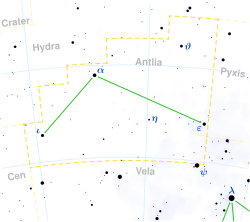Antlia
| Constellation | |
 List of stars in Antlia |
|
| Abbreviation | Ant |
|---|---|
| Genitive | Antliae |
| Pronunciation | /ˈæntliə/, genitive /ˈæntlɪ.iː/ |
| Symbolism | the air pump |
| Right ascension | 10 h |
| Declination | −30° |
| Quadrant | SQ2 |
| Area | 239 sq. deg. (62nd) |
| Main stars | 3 |
| Bayer/Flamsteed stars |
9 |
| Stars with planets | 1 |
| Stars brighter than 3.00m | 0 |
| Stars within 10.00 pc (32.62 ly) | 2 |
| Brightest star | α Ant (4.25m) |
| Nearest star | DEN 1048-3956 (13.17 ly, 4.04 pc) |
| Messier objects | 0 |
| Meteor showers | None |
| Bordering constellations |
Hydra Pyxis Vela Centaurus |
| Visible at latitudes between +45° and −90°. Best visible at 21:00 (9 p.m.) during the month of April. |
|
Antlia (from Ancient Greek ἀντλία) is a constellation in the southern sky. Its name means "pump" and it specifically represents an air pump. The stars comprising Antlia are faint, and the constellation was not created until the eighteenth century. Beginning at the north, Antlia is bordered by Hydra the sea snake, Pyxis the compass, Vela the sails, and Centaurus the centaur.
Contents |
History
Antlia was created by the French astronomer Abbé Nicolas Louis de Lacaille, who created fourteen constellations for the southern sky to fill some faint regions. It was originally denominated Antlia pneumatica to commemorate the air pump invented by the French physicist Denis Papin.[1] The International Astronomical Union subsequently adopted it as one of the 88 modern constellations. There is no mythology attached to Antlia as Lacaille discontinued the tradition of giving names from mythology to constellations and instead chose names mostly from scientific instruments.
Notable features
- See also: List of stars in Antlia
Antlia is devoid of bright stars. The brightest star is α Antliae, a magnitude 4.25m orange giant. Antlia contains the following deep sky objects:
- NGC 2997, a spiral galaxy of type Sc which is inclined 45° to our line of sight.
- The Antlia Dwarf, a 14.8m dwarf spheroidal galaxy that belongs to our Local Group of galaxies. It was discovered only as recently as 1997.[2]
Citations
- ↑ Star Tales. "Antlia". http://www.ianridpath.com/startales/antlia.htm. Retrieved 2007-12-03.
- ↑ APOD: April 23, 1997 - Antlia: A New Galactic Neighbor
References
- Ian Ridpath and Wil Tirion (2007). Stars and Planets Guide, Collins, London. ISBN 978-0007251209. Princeton University Press, Princeton. ISBN 978-0691135564.
External links
|
|||||||||||
|
|||||
|
||||||||||||||||||||||||||||||||